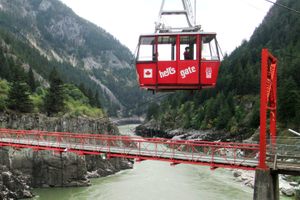
The Fraser River rises near the Alberta border and flows some 1375 kilometers (about 854 miles) through British Columbia, entering the Strait of Georgia just south of Vancouver. The main stem is undammed, and supports a large salmon run, which has disproportionate economic importance now since the salmon run in so many rivers has been devastated by dams. At Hell's Gate, in Fraser Canyon, the river flows through a constriction only 35 meters (about 115 feet) wide. Migrating salmon can usually pass this barrier, but with difficulty.
The Fraser River took on new importance as a transportation corridor after the establishment of the 49th parallel as the U.S.-Canada boundary in 1846, since the river runs completely north of the boundary. Even though the Fraser is only navigable up to Yale, about 160 kilometers from the coast, the goldfields upstream on the Fraser motivated construction of primitive roads, including the Cariboo Road.
One result is that the Fraser became the main route from the rest of Canada to the Pacific coast. Hence the Canadian Pacific Railway was built along the Fraser and through Fraser Canyon in the 1880s, on the west side of the river. The Canadian National Railway followed in the early 20th century, on the other side of the river, but there was a hitch: building a new tunnel in 1914 caused a large rockfall into the river at Hell's Gate, partly choking the river and making it impassable for many salmon.
Years of recriminations and acrimony followed, as efforts to remove the rockfall interfered with traditional fishing rights. There were even international ramifications, as U.S. and Canadian scientists disagreed as to how to best restore the salmon run. The installation of "fishways" to bypass the choke point have proven effective, as have limitations on the salmon catch.
In 1971, the Hell's Gate Airtram opened. A 22-passenger gondola runs from a station on the Trans-Canada highway, east of the river, down to the west bank of the Fraser just above Hell's Gate itself. The overall elevation difference is about 157 meters (515 feet), and the distance across the river is some 318 meters (1043 feet). The cable is anchored only at each end, and is said to be the steepest non-supported tramway in North America.
At the river level is a restaurant, gift shop, and interpretive displays about the river and salmon run. A footbridge over the river is also open to the public.
0 comments:
Post a Comment